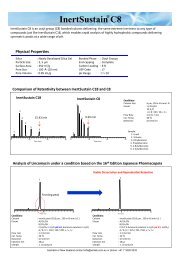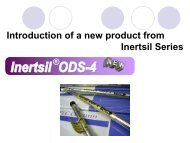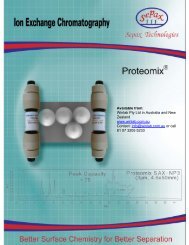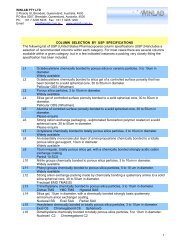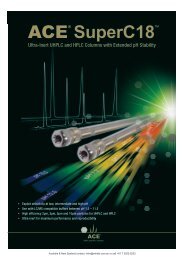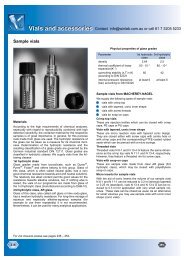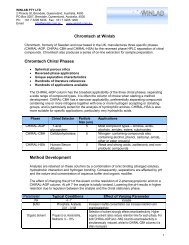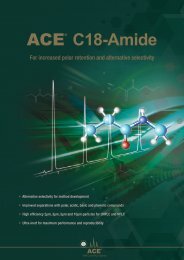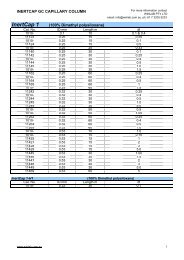Method Development Guide (rev. 05/04) - Winlab.com.au
Method Development Guide (rev. 05/04) - Winlab.com.au
Method Development Guide (rev. 05/04) - Winlab.com.au
Create successful ePaper yourself
Turn your PDF publications into a flip-book with our unique Google optimized e-Paper software.
Zirconia-Based Columns for HPLCIncludesNEWQuick-Start<strong>Guide</strong>!Reversed-Phase<strong>Method</strong><strong>Development</strong><strong>Guide</strong>Column Use Tipstel 1-866-STABLE-1 / fax 1-763-421-2319 / www.zirchrom.<strong>com</strong>
PART I / QUICK-START GUIDEStart-up Procedure 2Installing the ColumnValidating Column PerformanceMobile Phase pHEquilibrating the ColumnUse at High Temperature or LC/MSZirChrom ® -PBD/ZirChrom ® -PS/ZirChrom ® -CARB/ 4DiamondBond ® -C18General Use TipsSpecial Considerations for Carbon ColumnsColumn Maintenance 6Cleaning/Regeneration ProcedureStorage ConditionsPART IIHigh Performance Reversed-Phase Chromatography 8General <strong>Method</strong> <strong>Development</strong> <strong>Guide</strong>lines for 10Zirconia-based Columns1. Phase Selection2. Mobile Phase Composition3. Buffer Composition4. pH Selection5. Temperature6. Analyte-Specific <strong>Guide</strong>linesPART IIIOther Products and Services 30
Quick-Start<strong>Guide</strong>1 Please read this guide carefully before using your new column.INTRODUCTIONThank you for purchasing a ZirChrom ® HPLC column. Due to its uniquecharacteristics—namely that its packing material is zirconia-based ratherthan silica-based, we strongly re<strong>com</strong>mend that you read this guide beforeusing your column. <strong>Method</strong> development with zirconia-based columnsinvolves different steps than those used with silica- or polymer-based columns.In this guide, we have outlined those steps and different chemistries. If at anytime you have questions about your column or method development, pleasecall our technical support line at 1-866-STABLE-1 (1-866-782-2531) to speak toone of our on-staff chemists, or email us at support@zirchrom.<strong>com</strong>.We will be happy to help you.
Quick-Start<strong>Guide</strong> 2PART I / QUICK-START GUIDEStart-up ProcedureThis section contains start-up guidelines to successfully install and equilibrateyour ZirChrom zirconia-based column.INSTALLING THE COLUMNConnect the column with the direction of the flow arrow on the labelpointing toward the detector. To maximize the life of your column, were<strong>com</strong>mend using a guard column. (Refer to your instrument’s manual forinformation on the proper installation of columns.)VALIDATING COLUMN PERFORMANCEUpon receipt of your column, duplicate the results on the Column Evaluationdocument enclosed with this guide. You should be able to achieve a platecount consistent with the operating conditions listed for your column. Be sureto inject roughly the same amount of material indicated on the chromatogram.Repeat this test periodically to track column performance over time.Slight variations may be obtained on two different HPLC systems due to systemelectronics, plumbing, operating environment, reagent quality,column condition and operator technique.MOBILE PHASE PHThe pH range for the mobile phase is 1-14.EQUILIBRATING THE COLUMN1. Equilibrate your column when it is installed for the first time. Verify thatyour mobile phase is miscible in the shipping solvent, which is acetonitrile.Always re-equilibrate the column before using it again after it hasbeen stored.2. The column can be used with any <strong>com</strong>mon organic modifier(i.e., acetonitrile, methanol, tetrahydrofuran or isopropanol).
Quick-Start<strong>Guide</strong>3 3. The column temperature may be set at any temperature up to 200 °C(150 °C for PBD and PS). (Note that for the best results, operating at elevatedtemperatures often requires special hardware not supplied withmost HPLC instruments.) Preferably, use the highest temperature consistentwith the stability of your analyte. ZirChrom columnsare stable up to 200 °C (150 °C for PBD and PS—refer to yourcolumn’s Care and Use sheet for exact temperatures).4. Purge the column with at least 10 column volumes of your mobile phaseuntil you achieve a stable baseline.USE AT HIGH TEMPERATURE OR LC/MSWe re<strong>com</strong>mend running at least two 30-minute gradients of 10-90%acetonitrile/water to condition your column before LC/MS or hightemperature use.
Quick-Start<strong>Guide</strong> 4ZirChrom ® -PBD/ZirChrom ® -PS/ZirChrom ® -CARB/DiamondBond ® -C18General Use Tips1. Upon receipt, we suggest you duplicate the results on the enclosedchromatogram. You should be able to achieve a plate count of at least90,000/meter for toluene under the operating conditions given on thechromatogram (80,000/meter for ZirChrom ® -CARB and DiamondBond ® -C18 for ethylbenzene). Be sure to inject roughly the same amount ofmaterial as indicated in the chromatogram.2. This column can be used with any <strong>com</strong>mon organic modifier(i.e., acetonitrile, methanol, tetrahydrofuran or isopropanol) but we findthat acetonitrile typically gives better plate counts. ZirChrom ® -PBD is lesshydrophobic than <strong>com</strong>mon silica-based supports. For simple non-ionic<strong>com</strong>pounds, we re<strong>com</strong>mend that you use about 10-30% less organicmodifier to obtain roughly the same retention as you would on a typicalC8 or C18 silica-based column.3. We very strongly advise that you use our columns at temperatureswell above ambient. At a minimum, we urge you to set the column to50 °C, but preferably to the highest temperature consistent with the stabilityof your analyte. We routinely use ZirChrom ® -PBD columns at 75 °Cand find them to be stable at 150 °C. We also re<strong>com</strong>mend that you setthe flow rate to 3 ml/min at these above-ambient temperatures. This willsubstantially increase the speed of analysis. The back pressure of zirconia-basedcolumns is remarkably low at room temperature anddecreases substantially at 50 °C and higher.4. When running basic <strong>com</strong>pounds on any stationary phase a buffer mustbe used (see ZirChrom Buffer Wizard at www.zirchrom.<strong>com</strong>).We strongly advise the use of phosphate, hydroxide, bicarbonate/carbonateor carboxylic acid (acetate, citrate) buffers instead of aminebuffers used with silica columns. Our first choice for cationic analytes is10-25 mM pH 7.0 ammonium phosphate buffers. However, this columnis stable from pH 1 to pH 14 and you can use any buffer you like in thispH range.
Quick-Start<strong>Guide</strong>5 5. When carboxylated molecules are chromatographed, we stronglyadvise the use of a ammonium phosphate buffer or above pH 6.0 anappropriate buffer (See Figure 12 for Buffering Ranges) plus 5mMammonium fluoride. A good buffer for carboxylates is 10-25 mMammonium phosphate at pH below 3.0. However, excellent resultscan be obtained at very low pH (pH < 1, do not use fluoride belowpH 4.0) and up to quite high pH (> 11).6. We re<strong>com</strong>mend the following prec<strong>au</strong>tions regarding day-to-dayoperation of the column:• Always check the solubility of the buffer being used when mixingwith organic mobile phases using an LC pump.• Avoid fluoride buffers below pH 4.• Avoid injecting metal chelating <strong>com</strong>pounds or proteins.C<strong>au</strong>tion: Do not use PEEK tubing at temperatures above 100 °C, or withtetrahydrofuran-rich mobile phases.Special Considerations for Carbon Columns (ZirChrom ® -CARB/DiamondBond ® -C18)• Routinely flush column with a strong solvent (i.e. 100% tetrahydrofuran)to elute any potentially retained materials off the phase. If necessary isopropanolor toluene may also be used to elute nonpolar contaminants.• Try operating at elevated temperature for optimal performance.Peak shape is often improved above 60 °C.• A small (1-5%) amount of a very strong solvent (i.e. tetrahydrofuran,octanol, octanitrile) often improves peak shape.
Quick-Start<strong>Guide</strong> 6Column MaintenanceTo maximize the life of this ultra-durable column, we re<strong>com</strong>mend the following:n Always use a guard column.n Clean up samples before injection (either filtering to removeparticulates or solid phase extraction techniques).nnnUse HPLC grade solvents and filter all solutions before use.Minimize pressure surges.Use an in-line filter (0.5 micron) in front of the column to catchlarge particles.n Routinely flush the column with a strong solvent to elute retainedmaterials off of the phase.n Flush all buffers and salts from the column before storage.Do not use PEEK tubing at temperatures above 100 °C or with mobilephases rich in tetrahydrofuran (> 10%).Please refer to your column’s Care and Use sheet for specific instructions.Cleaning/Regeneration ProcedureCarboxylic acids, fluoride and phosphate all adsorb strongly tozirconia-based columns. To fully remove these from the zirconia surface,or to remove substances that may have fouled the column, usethe following three-step cleaning protocol (*IMPORTANT*—Duringthese steps, you should remove your detector from the flow path toprotect it from aggressive cleaning conditions):1. Flush column with a mixture of 20/80 acetonitrile/0.1 M sodiumhydroxide or tetramethyl ammonium hydroxide for 50 column volumesat ambient temperature. Follow base wash with 10 column volumes ofwater at ambient temperature.2. Flush column with a mixture of 20/80 acetonitrile/0.1 M nitric acid for 50column volumes at ambient temperature. Follow acid wash with 10column volumes of water at ambient temperature.3. Flush column with 100% organic solvent for 20 column volumesat ambient temperature. For ZirChrom ® -PBD and ZirChrom ® -PS,methanol, acetonitrile, isopropanol, and tetrahydrofuran are all adequatesolvents. For ZirChrom ® -CARB and DiamondBond ® -C18, the sameorganic solvents can be used, however, the solvent should contain atleast 20% tetrahydrofuran (do not use PEEK tubing).
Quick-Start<strong>Guide</strong>7 Storage Conditions for ZirChrom ® -PBD/ZirChrom ® -PSDo not store your column in phosphate buffer.Refer to your column’s Care and Use sheet, but in general, ZirChromzirconia-based columns should be flushed with 50/50 organic modifier/water for 30 column volumes prior to storage overnight. For long-termstorage, flush the column with 5/95 organic modifier/0.1 M ammoniumhydroxide for 10 column volumes, followed by 50/50 organicmodifier/water.Storage Conditions for ZirChrom ® -CARB/DiamondBond ® -C18Do not store your column in phosphate buffer.We strongly suggest flushing the column with 50/50 organic modifierwaterfor 30 column volumes, followed by flushing with 100% tetrahydrofuran(do not use PEEK tubing) for 10 column volumes andre-equilibration with 50/50 organic modifier-water prior to storageovernight. For long-term storage, we re<strong>com</strong>mend flushing the columnwith 5/95 organic modifier/0.1 M ammonium hydroxide first, followedby 50/50 organic modifier-water and 100% tetrahydrofuran (do not usePEEK tubing) for 10 column volumes each, followed by re-equilibrationwith 50/50 organic modifier-water.
8PART IIHigh-Performance Reversed-Phase ChromatographyReversed-phase separations employ a polar eluent and a nonpolar(hydrophobic) stationary phase. The hydrophobic layer (or phase) is bondedonto a rigid support that can withstand the high pressures <strong>com</strong>monly usedin HPLC. Until recently, about 80% of all HPLC methods specified silica-basedstationary phases. However, silica does have some limitations:• Silica is readily soluble in aqueous solutions at pHs higher than 7.5.• Bonded silicas may briefly resist chemical attack at higher pHranges—but silica exposed through the coating is attacked andprogressively broken down.• Many silica-based bonding chemistries are not stable at hightemperatures (> 40 °C).• Hydrolysis of the siloxane bond at low pH, resulting in stationaryphase “bleed”, leads to retention time irreproducibility and highbackground noise for LC/MS applications.Polymeric column packings frequently exhibit shrinking or swelling asmobile phase modifier <strong>com</strong>position changes. They are inherently less efficientthan silica and zirconia based particles for most separations.Zirconia-based columns are <strong>rev</strong>olutionary HPLC phases. Zirconia particlesare mechanically stable, and have a porous structure similar to that of silica.However, zirconia’s main advantage over silica is that it is very stable in awide range of eluent pH—and more importantly, at elevated temperatures—upto 200 °C (150 °C for PBD and PS). This makes ZirChromcolumns ideal for rugged, robust <strong>rev</strong>ersed-phase HPLC separations.3µm 25µm2µmNPZ3 µm 50 µm 500X800 nm 30000XFigure 1. Porous and Nonporous Zirconia Particles
9 Why is Temperature Important?For any HPLC system, raising the column temperature does the following:• Increases column efficiency—for sharper peaks and better separation.• Reduces mobile phase viscosity—so you can increase eluent flowrate with low back pressure, and achieve a much faster separation.ZirChrom’s highly efficient, ultra-stable columns let you developmethods that run up to 5 or more times faster with equal or better resolutionat temperatures that degrade the typical silica-based column.You get faster analysis, better resolution and longer column lifefor a robust method.ZirChrom columns differfrom silica-based columnsin the following areas: Greater flexibility/for yourmethod development—Work at both high andlow pH (from 1-14). Longer column life—Zirconia won’t degradein extreme conditions orat high temperatures. Faster separations—Higher temperaturesenable faster analysis. Tunable selectivity—Zirconia surface chemistrycreates mixed-mode possibilities(and affects bufferselection for ionic analytes).NOW AVAILABLE -ShortZirChrom Columns for UltraFast High Temperature LiquidChromatography (UFHTLC).ZirChrom now offers short (2cm) all-stainless steel columnsfor ultra-fast high temperature<strong>rev</strong>ersed-phase liquid chromatography.These columnsare only sold in sets of two(mixed sets are available).Contact ZirChrom technicalsupport at 1-866-STABLE-1 orsupport@zirchrom.<strong>com</strong> formore details.
10General <strong>Method</strong> <strong>Development</strong> <strong>Guide</strong>lines forZirconia-based ColumnsZirconia-based phases are much closer to silica-based phases in behaviorthan are polymeric and carbon-based phases, but yet significantly differfrom silica in several important ways.The method development differences between silica-based and zirconiabased<strong>rev</strong>erse-phase method development can be illustrated as follows:Operational Similarities for Silicaand Zirconia RP Media• k’ increases with molecularhydrophobicity (-CH 3 , -CH 2- ,phenyl, etc.).• Similar elution sequence of nonelectrolytes.• k’ decreases 2-fold per 10%increase in volume % organicmodifier.• Log k’ versus % organicmodifier is linear.• k’ decreases as temperature isincreased (3-fold/50 °C).• Solvent strength: tetrahydrofuran> acetonitrile > methanol.• ZirChrom ® -PBD and ZirChrom ® -PS<strong>rev</strong>ersed-phases are veryefficient (N > 90,000 plates/meter) hydrophobic, inorganicbased,stationary phases.note: k’ = retention factorOperational Differences in Silicaand Zirconia RP Media• Cations are typically moreretained and sometimes muchmore retained on zirconia inbuffered (PO 4 ) eluents than on silicaphases.• Elution sequence of anions andcations can be very different onzirconia and silica at neutral pH.• Must use Lewis base eluent forcarboxylated analytes. Stronglyadvise use of 5 mM or more phosphate(or tetramethylammonium hydroxide) forall electrolytes.• Lewis base modifier at mid-rangepH creates mixed-mode <strong>rev</strong>ersephase/ion-exchangepossibilities.• Use 10-30% less organic modifier (depending on phase andanalyte) .• k’ of bases DECREASES at pHabove pKa!Visitwww.zirchrom.<strong>com</strong>to request yourZirChromChromatographyEssentials MiniCD-ROM today!
11 1. Phase SelectionZirChrom offers the following types of <strong>rev</strong>erse-phase columns:• ZirChrom ® -PBDZirChrom ® -PBD (polybutadiene) is a general-purpose columnintended for basic <strong>com</strong>pounds, similar to ODS for non-electrolytes.The zirconia is coated with a thin polymer layer. Phase selectivityis most similar to conventional ODS silica bonded phases.• ZirChrom ® -PSZirChrom ® -PS (polystyrene), an alternative to ODS selectivity,is ideal for highly aqueous mobile phases. It also features a thinpolymer coating.• ZirChrom ® -CARBZirChrom ® -CARB is made by coating zirconia with a very thin layerof elemental carbon. This column is particularly ideal for diastereomers/geometricisomers. The chemistry of carbon-based <strong>rev</strong>ersedphasesare very different from typical RPLC phases. When a different<strong>rev</strong>ersed-phase selectivity is required, ZirChrom ® -CARB offers a highefficiency alternative to most silica-based stationary phases.• DiamondBond ® -C18DiamondBond ® -C18 uses a proprietary covalent bonding technologyto graft C18 groups to carbon’s surface, giving it outstanding stabilityfor LC/MS applications. DiamondBond ® -C18 has selectivity that isintermediate between ODS silica and unbonded carbon supports.Please keep in mind throughout the method development process thatZirChrom ® -PS and ZirChrom ® -PBD phases have different selectivities,especially for highly aromatic <strong>com</strong>pounds.ZirChrom ® -PS is significantly less retentive than ZirChrom ® -PBD, just asPhenyl-Silica is less retentive than C18-silica.The selectivity and retentivity of ZirChrom ® -PBD is more like a C8/C18-silicaphase, where as that of the ZirChrom ® -PS is more like a Phenyl-silica phase.ZirChrom ® -CARB will have very different selectivity and more retention,especially for polar <strong>com</strong>pounds and highly aromatic <strong>com</strong>pounds.DiamondBond ® -C18 selectivity and retentivity will be intermediate betweenZirChrom ® -PBD and ZirChrom ® -CARB.
12Reversed-Phase Column Selection <strong>Guide</strong>Current Problem/Concern Column Suggested ConditionsImproved SelectivityNeed improved selectivity DiamondBond ® -C18, Use an acetonitrile and/orfor nonelectrolytes, ZirChrom ® -CARB tetrahydrofuran eluent.isomers, diastereomers.Set column temperatureCurrently using carbon,> 50 °C. Add octylaminecyano, phenyl or fluoroto improve peak shape.phases.Need improved selectivity ZirChrom ® -MS, Use buffer of your choicefor bases. ZirChrom ® -PBD in a pH range of 1 - 10. Ifrequired, 5 - 25 mM PO 4may improve peak shape.If using ZirChrom ® -PBD,increase pH above pKa(stable up to pH 14).Need improved selectivity DiamondBond ® -C18, Use 5 - 25 mM phosphate,for acids. ZirChrom ® -EZ, pH 7.0. If not effective,ZirChrom ® -MS drop pH to 2 or lower.Change RetentionNeed more retention for DiamondBond ® -C18, Can use in high watervery polar (hydrophilic) ZirChrom ® -CARB mobile phase.nonelectrolytes. Currentlyusing nearly 100% watereluent or polar embeddedphase.Need more retention for ZirChrom ® -MS Use buffer of your choicevery polar bases. Currentlyin a pH range of 1 - 10. Ifusing nearly 100%water required, 5 - 25 mM PO 4eluent or polar embeddedmay improve peak shape.phase or sulfonic acidHigh water mobile phasespaired ion reagent.are no problem.Need more retention for DiamondBond ® -C18, Use buffer of your choicevery polar acids. Currently ZirChrom ® -EZ, in a pH range of 1 - 10. Tryusing nearly 100%water ZirChrom ® -MS low pH first. 5 - 25 mMeluent or polar embeddedPO 4 may improve peakphase or quaternary amineshape.paired ion reagent.Need less retention with ZirChrom ® -PS Least hydrophobic phase.any solute type. Can be used with 100%water eluent.
13 Current Problem/Concern Column Suggested ConditionsImprove Efficiency/ProductivityInadequate stability and All ZirChrom ® Zirconia phases exhibitselectivity. Having trouble Reversed-Phase (RP) excellent pH and temperwithsilica-based phases, Columns ature stability. ZirChrom ®changed to alumina orRP columns give higherpolymer column andefficiency and better peakproblems were still notshape than alumina orsufficiently resolved.polymer columns.Poor column reproducibility. All ZirChrom ® Zirconia phases are veryExperiencing retention RP Columns reproducible from batchchangesat extreme pH, atto-batch, column-toelevatedtemperature orcolumn, and run-to-run.when using phosphate orEvery column is QCed.carbonate buffer.Separations taking too long. All ZirChrom ®RP ColumnsIncrease temperature up tomax. operating range forLC and/or analyte. Increaseflow rate. Easily improvesspeed 2-3 fold.Column overloaded too ZirChrom ® -MS, The mixed-mode (<strong>rev</strong>ersedeasilywith basic solutes. ZirChrom ® -PBD phase / cation exchange)retention mechanismenables enhanced columnloadability.Improve Detection SensitivityNeed to go to shorter ZirChrom ® -PS Use a high water or purewavelength to enhancewater eluent and go deepsensitivity in UV.into UV.Need to decrease bleed All ZirChrom ® All ZirChrom ® columnsin LC/MS. RP Columns are extremely low bleed.The ZirChrom ® -MS columnwas designed for LC/MS.For help, call our technical support group at 1-866-STABLE-1 orsupport@zirchrom.<strong>com</strong>.
142. Mobile Phase CompositionZirChrom columns can be used with many <strong>com</strong>mon organic modifiers,including acetonitrile, methanol, tetrahydrofuran and isopropanol. Formobile phase optimization, follow these steps:• Define optimum solvent strength so that 1< k’ < 20.• Do stepwise isocratic study in 20% steps starting at 100% organic.• Do gradient determination of % organic.• Define the best type of modifier: acetonitrile, methanol ortetrahydrofuran.• Keep in mind that the order of eluent strength is tetrahydrofuran >acetonitrile > methanol.Acetonitrile is usually the eluent of choice due to its superior UVabsorbance and low viscosity.Special Considerations when Choosing an Organic Modifier forCarbon Columns (ZirChrom ® -CARB / DiamondBond ® -C18)Special consideration must be taken when choosing an organic modifieradditive for use with carbon-clad <strong>rev</strong>ersed phase materials (i.e. ZirChrom-CARB and DiamondBond-C18), particularly for separations involvingstrongly retained analytes such as highly conjugated aromatic or planar flatmolecules. <strong>Method</strong> development issues such as peak tailing, low columnefficiency, and ir<strong>rev</strong>ersible adsorption can often be over<strong>com</strong>e with theinclusion of a relatively small amount (1 -10%) of a very strong solvent additivein the organic portion of the mobile phase. Widely employed “strong”HPLC solvents such as tetrahydrofuran (THF) are extremely effectivemobile phase additives for carbon phases, however, they also have somelimitations including: high absorbance at low UV wavelengths, in<strong>com</strong>patibilitywith PEEK tubing, peroxide formation, and general toxicity. In aneffort to discover alternatives, we systematically studied the use of smallamounts (0.1-10% (v/v)) of aliphatic alcohols, nitriles, and amines of increasingchain length as mobile phase additives to improve the chromatographicperformance of strongly retained <strong>com</strong>pounds (in this casesteroidal <strong>com</strong>pounds) on our carbon phases. To study the effects of theseadditives, a base mobile phase of 70/30 ACN/water was used with a 100 mmx 4.6 mm i.d. ZirChrom-CARB column at 80 o C, and the retention, peak
15 shape, and efficiency of three anabolic steroids were measured as a functionof the amount and type of additive used. As an example, to test theeffect of 1% 1-octanol, a fraction of the ACN was replaced with the 1% 1-octanol such that the total volume fraction of organic modifier remainedthe same (i.e. 69/1/30 ACN/1-octanol/water).Figure 2 shows the effect of adding only 1% of several different 8-carbonadditives (octanol, octanenitrile, octanedinitrile, and octylamine) on theretention of the three steroids, in <strong>com</strong>parison to the 70/30 ACN/watermobile phase alone, and the use of 10% THF (i.e. 60/10/30 ACN/THF/water).These data show that even small amounts of these 8-carbon additives havea profound effect on the retention of highly retained <strong>com</strong>pounds.Figure 2
16Figures 3-5 show that as the length of the alcohol, nitrile, or amine modifierthat is used is increased, the retention of the steroids decreases. Alsoshown in Figures 3-5 is that a broad range of solvent strength is availablethrough the use of relatively innocuous solvents such as octanol, significantlyreducing the need for more unfriendly solvents such as THF.Figure 3Figure 4
17 Figure 5Compared to the large dependence of the retention on the type of additiveused, the effects on the peak shape and efficiency were much less dramatic,however the peak shape and efficiency did improve with decreasingretention. When working with UV detection, it is important to be mindfulof the background absorbance of the mobile phase, particularly whenworking with low UV wavelengths. Figures 6 and 7 show UV spectra in thewavelengthrange of 200-300nm for mixturesof all of the additives<strong>com</strong>paredin this work,where each mixtureconsisted of65% ACN, 30%water, and 5%(v/v) of the indicatedadditive.Several of theadditives werenot available asFigure 6
18HPLC grade solvents which is reflected in some of the spectra shown inFigure 7.The similarityof the spectrafor all of themixtures containingHPLCgrade additivesshown inFigure 6 suggeststhat thestrongest solventadditiveavailableshould beFigure 7used so thatthe leastamount of additive will be required to achieve the desired retention,thereby allowing the smallest background absorbance due to the mobilephase. Of course if one is working with a mass spectrometer as a detector,the issue of additive purity is not one of UV absorbance, but rather massspectral interference.3. Buffer CompositionObtaining satisfactory peak shape for your analytes requires the properchoice of a Lewis base buffer. Buffers improve peak shape of acidic<strong>com</strong>pounds and can help modify the band spacing (or selectivity) andretention of acidic or basic <strong>com</strong>pounds. Furthermore, if you are separatingcarboxylic analytes, you must use a Lewis base eluent. We stronglyre<strong>com</strong>mend 5 - 25 mM phosphate (or tetramethyl ammoniumhydroxide for LC/MS <strong>com</strong>patibility) for electrolytes (see Figure 8).
19 A Difficult Separation: Alkyl Benzoic AcidsSolved on ZirChrom ® -PBDProblem?1SOLUTES1 - Benzoic acid2 - Ethylbenzoic acid3 - Butylbenzoic acid230 1 2 3 4minLC CONDITIONSMobile phase: 30/70 ACN/25mM Ammonium acetate, 5mM Ammonium fluoride, pH 4.0Flow rate: 1.0 ml/minInjection volume: 1 mlTemperature: 35 °CDetection: 254 nm50 mm x 4.6 mm…No Problem—Just Add Phosphate Buffer!2310 1 2 3 4minLC CONDITIONSMobile phase: 30/70 ACN/25mM Phosphoric acid, pH 2.2Flow rate: 1.0 ml/minInjection volume: 1 mlTemperature: 35 °CDetection: 254 nm50 mm x 4.6 mmFigure 84. pH SelectionBec<strong>au</strong>se ZirChrom columns are ultra-stable at low or high pH, they areideal for the following:• Ionizable <strong>com</strong>pounds• Improving peak shape of acidic or basic <strong>com</strong>pounds• Changing selectivity or retention of acidic or basic <strong>com</strong>poundsFor more information on how pH can affect method development on basicanalytes (see page 25).
2<strong>05</strong>. TemperatureAlthough ZirChrom columns are excellent at room or slightly elevatedtemperatures, to speed any analysis, raise the temperature! ZirChromcolumns reach cruising speed at 80 °C and withstand temperatures up to200 °C (150 °C for PBD and PS)—without degrading.Set your flow rate to 3 ml/min (for a 4.6 mm i.d. column) at these superambienttemperatures. This will substantially increase the speed of analysis.The back pressure of zirconia-based columns is remarkably low at roomtemperature and decreases substantially at 50 °C and higher.12-C18, 100 mm x 4.6 mmTemperature: 21 oCAnalysis time: 43 min.ACN/Buffer: 18.5/81.5Flow rate: 1.4 ml/min.Resolution (min; 3,4): 2.234534ANALYTES1 - Barbital2 - Butabarbital3 - Pentobarbital4 - Carbromal5 - Secobarbital6 - Methohexital60 5 10 15 20 25 30 35 40 min1234Temperature: 50 oCAnalysis time: 27 min.ACN/Buffer: 13.5/86.5Flow rate: 2.3 ml/min.Resolution (min; 3,4): 2.153640 5 10 15 20 25 30 35 40 min12345Temperature: 80 oCAnalysis time: 21 min.ACN/Buffer: 8.8/91.2Flow rate: 3.2 ml/min.Resolution (min; 3,4): 2.26340 5 10 15 20 25 30 35 40 minLC CONDITIONSMobile phase: ACN/5 mM Ammonium phosphate, pH 7.0Pressure drop: 192 barInjection volume: 1.3 µlFigure 9
21 Analyte-Specific <strong>Guide</strong>lines<strong>Method</strong> <strong>Development</strong> for NonelectrolytesFor any nonelectrolyte analyte at neutral pH (e.g. ester, ether, alkane,alkene, alkyne, amides, alcohols, etc.) which is not a carboxylic acid oramine you should choose the eluent just as you would for a Type A or B silica-basedphase. However, we suggest that you use about 10-30% lessorganic modifier than you would with a silica-based phase. If you wouldnormally start method development with 80% acetonitrile on a typical ODSphase we suggest you use 60-70% acetonitrile on our ZirChrom ® -PBD,ZirChrom ® -CARB and DiamondBond ® -C18 phases and indeed even a lowerpercentage of organic (say 50-60%) on our ZirChrom ® -PS phase. This willput the k’ in the same range as you would observe on a silica-based phase.If in normal method development you would change the strong solvent by5% to either increase or decrease retention we suggest you make the sameapproximate change in <strong>com</strong>position using zirconia-based phases.The chromatographic selectivity of ZirChrom ® -PBD and ZirChrom ® -PSzirconia columns will be similar (but not exactly the same) as ODS andphenyl type bonded phases on silica respectively (J. Zhao and P.W. Carr,“Synthesis and Evaluation of an Aromatic Polymer-Coated Zirconia forReversed Phase Liquid Chromatography,” Anal. Chem., 71, 5217-24 (1999)).Substituents which c<strong>au</strong>se an increase in retention on silica phases c<strong>au</strong>se anincrease in retention of zirconia, and uncharged substituents that decreaseretention (e.g. OH, NO 2 , CHO, etc.) on silica c<strong>au</strong>se a decrease in retentionon zirconia phases.ZirChrom ® -CARB has RPLC-like properties, but has radically different selectivitythan ODS or ZirChrom ® -PBD, which is great for steroids and geometricisomers. Much more hydrophobic than ODS, it is great for polaranalytes. DiamondBond ® -C18’s retention properties are intermediatebetween ZirChrom ® -CARB and ODS silica columns. DiamondBond ® -C18and ZirChrom ® -CARB are very stable, and can be used at low and high pH,as well as at high temperatures. Lewis acid-base properties are still importanton all zirconia-based phases. Peak shapes are best with tetrahydrofuran(10%) and/or elevated temperature.
22<strong>Method</strong> <strong>Development</strong> for Ionic (Cations and Anions) AnalytesIn the method development process for ionic analytes on zirconia-basedphases, one must understand that zirconia’s surface contributes significantlyto the total retention of the analyte through electrostatic interactionsbetween the analyte and the surface. These electrostatic interactions arein addition to the <strong>rev</strong>ersed-phase interactions that take place in RPLCbetween the analyte and the hydrophobic stationary phase. The extent towhich the zirconia surface contributes to the retention of the analyte isdetermined by three principal factors:1. The pH of the mobile phase affects both zirconia’s surfacecharge and the charge state of the analyte.2. The type of buffer used in the eluent.3. The pK a of the analyte.The effects of the pH of the mobile phase on the surface charge onzirconia and silica are best illustrated in Figure 10a and 10c. The zirconiasurface is populated by several species of Lewis, and Brönsted acid sites, aswell as Brönsted base sites, which have charge states that are highly dependenton the mobile phase pH.Understanding the interactions p<strong>rev</strong>iously outlined is critical to successfulmethod development for ionic analytes. Please note that the behavior ofzirconia indicated in Figure 10 and the p<strong>rev</strong>ious discussion is dramaticallydifferent from the behavior observed with traditional silica-based stationaryphases. The zirconia surface inherently contains more charged sitesthan does silica due to ionization of surface species and adsorption of hardLewis bases (See Figure 10b). Consequently, electrostatic interactionsbetween the analyte and the zirconia surface are potentially much moresignificant than in the analogous case encountered with silica-basedphases. The information presented so far has been very general, a morethorough consideration of conditions for both acidic and basic analytes isgiven below.The retention (k’) and selectivity (α , band spacing) of zirconia-basedphases for positively charged species is frequently, and indeed almostalways, very different than for any silica-based phase and at this point it isdefinitely best to think of zirconia as the “un-silica”.
23 Figure 10<strong>Method</strong> <strong>Development</strong> for Carboxylic Acid (Anionic) AnalytesWithout question carboxylic acid containing analytes are the mostchallenging species in terms of method development with zirconia-basedphases. It is absolutely essential that the eluent contain a fairly high concentration(> 20 mM) of a stronger, harder Lewis base (Figure 11) to obtainacceptable plate counts and peak shapes. Fortunately for low molecularweight monocarboxylate analytes, this problem has been solved. If thesample is a simple carboxylic acid as exemplified by benzoic acid (as areibuprofen, naproxen, etc.), it is easy to obtain good peak shape. Westrongly suggest the use of dilute phosphoric acid (pH 2-2.5, 20-50 mM), orfluoride plus a suitable buffer (pH > 4, 20-50 mM) as the aqueous <strong>com</strong>ponentof the mobile phase, a column temperature of 40 °C or higher, andacetonitrile as the organic <strong>com</strong>ponent of the eluent.
24Bec<strong>au</strong>se all proteins have multiple carboxylate groups they act aschelating agents and they adsorb ir<strong>rev</strong>ersibly to <strong>rev</strong>ersed phase zirconiasupports in aqueous-organic media. We strongly advise against doingRPLC of proteins with zirconia-based <strong>rev</strong>ersed-phases, but rather re<strong>com</strong>mendion-exchange chromatography of proteins using any of ourfour zirconia-based ion-exchange materials. We must point out thatpolycarboxylate <strong>com</strong>pounds such as EDTA and other <strong>com</strong>pounds thatare able to chelate metals by having two or more functional groups(COOH, aromatic OH) positioned in the analyte so as to be able toform 5 or 6 membered rings and thus chelate surface Zr(IV) sites canstill give problems on zirconia-based columns.Interaction Strength of Several Commonly-UsedLewis Base AdditivesInteraction StrengthLewis BaseStrongestWeakestHydroxidePhosphateFluorideCitrateSulfateAcetateFormateNitrateChlorideFigure 11
25 <strong>Method</strong> <strong>Development</strong> for Basic (Cationic) AnalytespH < 2In this pH range our favorite buffers are strong acids such as 25mM phosphoricacid (excellent UV transparency and relatively noncorrosive). Don’tbe surprised if the elution orders and band sequences are very different atlow pH on zirconia-based phases relative to those on silica-based phases.You must keep in mind that in the phosphoric acid the surface of zirconiahas a net negative charge, whereas silica is uncharged at pH < 2. These veryacidic conditions are very good for chromatography of amines, as almost allamines will be positively charged at these very low pHs, allowing for uniquemixed mode (ion-exchange and <strong>rev</strong>ersed-phase) selectivity.The postive counterion concentration when using a phosphoric acid mobilephase is quite low and may need to be increased in order to obtain satisfactorypeak shape for amines in this pH range. However the best peak shapesfor amines are often obtained by using mobile phase pH ranges at least 1.5pH units above the pK of the positively charged species (see page 28).We strongly re<strong>com</strong>mend that you consult with your instrument manufacturerto determine the <strong>com</strong>patibility of your instrument with these very acidic conditions.The use of fluoride buffers below pH 4 is not advised as HF will c<strong>au</strong>sedamage to any HPLC column and your HPLC instrument. Also keep in mindthat there are significant differences in retentivity and selectivity of our zirconiabased <strong>rev</strong>ersed-phases so if the selectivity is not adequate on one phase it maybe adequate on another. All phases can be used at very high water content (>95%).ZirChrom-EZ offerslow pH LC/MS<strong>com</strong>patibility forcationic anlytes. Seethe ZirChrom-EZmethod guide formore details!
262 < pH < 6It is frequently the case that the retention of more hydrophilic (polar) basesis very low in strongly acidic media on silica and zirconia-based phases.If analyte retention is too low (k’ < 1) in highly acidic media (pH < 2)and you still want to work at low pH we suggest that you use a dilute(2-5 mM) but highly acidic phosphoric acid/phosphate buffer at pH 1.8to 3.0, where phosphate has a high buffer capacity. Phosphate and citratebuffers and formate to a lesser extent are <strong>com</strong>prised of very strong hardLewis bases, which chemically adsorb on the surface of zirconiaand impart a negative charge. This negative charge does three things:1. It increases retention (k’) of positively charged bases.2. It substantially increases their loading capacity.3. It has a tremendous effect on band spacing (selectivity)and elution order.The first task is always to find conditions where retention is adequate(k’ > 0.5-1 for the least retained analytes) and only then should one attemptto optimize the selectivity. Keep in mind that on zirconia-based phases,even at constant pH, retention will vary with the concentrationof the buffer and any added “inert” salts such as ammonium chloride.If the separation is still not adequate due to low retention or inadequateband spacing then we suggest exploring the use of other buffer types andhigher pHs. Citrate buffers can be used from pH 2.1-6.4 and fluoridebuffers are very useful on zirconia since they are hard Lewis bases andadsorb on the surface. A more <strong>com</strong>plete listing of buffers to use at a givenpH is shown in Figure 12. We also encourage you to try out our fully <strong>au</strong>tomatedBuffer Wizard on our website at www.zirchrom.<strong>com</strong>.If you really need to increase retention we advise the use of a dilute(2-5 mM) ammonium phosphate or ammonium fluoride buffer at pH 4-8.Our number one choice for a starting buffer in this case is 2-5 mM ammoniumfluoride, plus 10-50 mM of either formic acid/formate or aceticacid/acetate to buffer the pH. Bec<strong>au</strong>se phosphate and fluoride adsorb verystrongly on zirconia’s surface at neutral pH, and bec<strong>au</strong>se all aliphaticamines are positively charged at pH < 8 you will generally see strongerretention of bases on zirconia phases than on silica phases in neutralphosphate and fluoride buffers. Thus use of neutral phosphate buffers
27 will c<strong>au</strong>se a significant increase in retention of bases on zirconia phasesrelative to use of an acidic eluent. If you then need to adjust selectivity weadvise addition of an inert salt such as ammonium chloride or to adjustthe electrostatic (charge-charge, or ion-exchange) interaction contributionto retention and selectivity.You can and should also adjust the volume fraction of organic modifier toadjust retention and type of organic to alter chromatographic selectivity.However, our experience indicates that the salt concentration and pH arehighly influential variables in terms of adjusting selectivity when dealingwith charged analytes. Keep in mind that aromatic amines (aniline andpyridine functionalities) are much less basic than aliphatic amines andthey tend to be deprotonated at pH > 5. Bec<strong>au</strong>se the anionic form of thebuffer will adsorb on zirconia, the type of buffer (acetate, citrate, phosphate,etc.) you use to achieve the desired pH will have a big effect on elutionorder, band spacing, retention and peak shape. This can be used veryadvantageously to adjust selectivity.pH suitability map for <strong>com</strong>monly used buffer systems.Acetic AcidFormic AcidCitric AcidBoric AcidBoric AcidPhosphoric Acid Phosphoric Acid Phosphoric AcidAmmoniaTrisTriethylaminePyrrolidineHydroxide0 2 4 6 8 10 12 14Figure 12. The lighter region of the red buffer range indicates the region of highestbuffering capacity. Please do not use buffers outside the indicated ranges
28pH > 6If selectivity is still not adequate at weakly acidic or neutral pH, it ispossible and advisable to go to still higher pH without c<strong>au</strong>sing any phasede<strong>com</strong>position of your zirconia-based column. As pH is increased from6 to 12 you can use any buffer you like that provides adequate buffercapacity. You are not restricted to the use of organic buffers (e.g. Tris,pyrrolidones, or triethylamine) or low operating temperatures as you areon silica-based phases. You can use phosphate, fluoride, borate, or carbonatebuffers. They will not c<strong>au</strong>se phase de<strong>com</strong>position. This is a definiteadvantage of Type-Z zirconia-based phases over Type-A and Type-B silicabasedmaterials. Additionally, 0.<strong>05</strong> M tetramethyl ammonium hydroxidehas proven to be an extremely useful buffer for cationic molecules at highpH and is <strong>com</strong>patible with LC/MS detection (however MS ionization andsensitivity of amines will be low at high pH).It is extremely important to understand that as the pH is raised above thepKa of the basic analyte, retention will decrease relative to retention in aphosphate or other hard Lewis base type buffer at neutral pH (4-9). Thisis bec<strong>au</strong>se the electrostatic interaction is “turned-off” at high pH. Soluteselute in order of their hydrophobicity. Retention of a set of basic drugsis nearly identical at pH 12 in both phosphate and ammonium hydroxidebuffers of very different ionic strength proving that there is no electrostaticcontribution to retention and selectivity (See Figure 13 &14). At high pH (>Figure 13
29 11.5) buffer type, concentration and inert salt concentration have very littleeffect. We advise the use of the organic type (i.e., acetonitrile, methanol,tetrahydrofuran or isopropanol) of the mobile phase to adjust selectivityand retention at high pH.TIP: Use ZirChrom ® -PBD to solve those basic <strong>com</strong>pound problemsrequiring high pH.ZirChrom ® -PBD Gives Excellent Peak Shapesfor Basic Drugs at High pH…In LC/MS-friendly amine buffer12ANALYTES1 - Labetalol2 - Acebutolol3 - Oxprenolol4 - Lidocaine5 - Alprenolol6 - Propranolol34560 0.5 1 1.5 2 2.5 3 3.5 4 4.5 minLC CONDITIONSMobile phase: 35/65 ACN/10 mM Triethylamine,50 mM Tetramethylammonium hydroxide, pH 12.2Flow rate: 1.0 ml/minInjection volume: 5 µlTemperature: 30 °CDetection: 254 nm150 mm x 4.6 mm…Or in phosphate buffer123450 0.5 1 1.5 2 2.5 3 3.5 4 4.5 minLC CONDITIONSMobile phase: 35/65 ACN/20 mM Potassium Phosphate, pH 12.2Flow rate: 1.0 ml/minInjection volume: 5 µlTemperature: 30 °CDetection: 254 nm150 mm x 4.6 mmFigure 146
30PART IIIOther Products & Services<strong>Method</strong> <strong>Development</strong> KitsNot sure which column is best for your application? Try one of ZirChrom’smethod development kits. Each kit contains 3 columns with different selectivityfor faster screening (columns are 4.6 mm x 50 mm; othersizes upon request).MK01 Ion Exchange <strong>Method</strong> <strong>Development</strong> Kit #1(contains 1 each of ZirChrom ® -SAX,ZirChrom ® -SHAX, and ZirChrom ® -WAX)MK02 Ion Exchange <strong>Method</strong> <strong>Development</strong> Kit #2(contains 1 each of ZirChrom ® -SAX,ZirChrom ® -WCX, and ZirChrom ® -PEZ)MK03 Reversed Phase <strong>Method</strong> <strong>Development</strong> Kit(contains 1 each of ZirChrom ® -PBD,ZirChrom ® -CARB, and DiamondBond ® -C18)Particle SizesZirChrom’s analytical columns are packed with 3 or 5 micron particles.On request, we can pack columns with 7, 10, or 25 micron particles,or larger, with identical chemistry, making scale-up using ZirChrom’sproducts fast and easy. All particles have 300 angstrom pores.Non-Porous ZirconiaZirChrom has available non-porous particles for ultra-fast chromatography.These particles are available in standard sizes of 1.0, 2.0 & 3.0 micron and inall of our normal phase and <strong>rev</strong>ersed phase chemistries. Ion exchange versionscan be custom made. Custom particle sizes up to 3.0 micron areavailable.Prep FormatsAll of our phases are available in semi-prep and prep formats. See ourTechnical Bulletin #196 for more information on easy scale-up to prep formats.
31 Microbore and LC/MS FormatsAll of our phases are available in microbore and LC/MS formatsupon request. Our <strong>rev</strong>ersed-phase columns have been shown to havesignificantly lower bleed than the leading silica phases in LC/MS,giving higher sensitivity.Normal Phase LC /ZirChrom ® -PHASEUnmodified zirconia particles make an excellent support for normalphase LC. ZirChrom-PHASE is packed into the same column formatsas our <strong>rev</strong>ersed phase and ion exchange supports. Specify ZR02when ordering.Technical SupportZirChrom’s products are often used in cutting edge separationswhere silica supports fail. Our technical support group has extensiveexperience, particularly in pharmaceutical and environmental HPLC.We are happy to assist you with your difficult separations.Buffer WizardThe ZirChrom BUFFER WIZARD is a web-based laboratory consultantdesigned to do the calculations needed to prepare buffers specificallyfor use in HPLC. In addition to doing the calculations it provides manyhelpful hints as to the proper choice of buffer and issues messages whenthe buffer capacity is too low to do the job or when too high or too low pHmight damage conventional stationary phases.To access the Buffer Wizard and other HPLC relevant data, visit theZirChrom Home Page (www.zirchrom.<strong>com</strong>).An advanced version of the Buffer Wizard with 50 buffer systems isavailable for sale (part# BW01; $100.00 list price).International Inquiries /OrdersInternational customers can reach ZirChrom directly at +1 (763) 421-5264.Our Fax number is +1 (763) 421-2319.Call us at 1-866-STABLE-1, (763) 421-5264 or e-mail our technical supportgroup at support@zirchrom.<strong>com</strong>.
32Notes
Notes33
Technical SupportOur technical support group has extensive experience, particularly inpharmaceutical and environmental HPLC. We are happy to assist youwith your difficult separations. Please contact us at 1-866-STABLE-1or support@zirchrom.<strong>com</strong>.For Peak PerformanceZirChrom manufactures a full line of zirconia-based high performanceproducts used for the analysis of <strong>com</strong>pounds by HPLC.Specialists in Ultra-Durable,High Efficiency HPLC PhasesZirChrom Separations, Inc.617 Pierce StreetAnoka, MN 55303T: 1-866-STABLE-1 (1-866-782-2531)F: 1-763-421-2319www.zirchrom.<strong>com</strong>support: support@zirchrom.<strong>com</strong>ZirChrom ® , ZirChrom ® -PBD, ZirChrom ® -PS,ZirChrom ® -CARB, and DiamondBond ® -C18 areregistered trademarks of ZirChrom Separations, Inc.© 2002 ZirChrom Separations, Inc.Printed in the U.S.A., May, 20<strong>04</strong>tel 1-866-STABLE-1 / fax 1-763-421-2319 / www.zirchrom.<strong>com</strong>



